MARIANI’S
Virtual
Gourmet
January
12, 2020
NEWSLETTER

Ann
Southern and Barry Sullivan in "Nancy Goes to Rio"
(1950)
❖❖❖
IN THIS ISSUE
DINING OUT IN MILAN
Part One
By John Mariani
NEW YORK CORNER
BROOKLYN CHOP HOUSE
By John Mariani
NOTES FROM THE WINE CELLAR
WINTER WHITES
By Geoff Kalish
❖❖❖
DINING OUT IN MILAN
By John Mariani
"Still Life" by Giorgio DeChirico
As the capital of Lombardy,
Milan is the center of banking, automaking,
textiles, fashion and publishing, which complement
each other to produce beautiful cars, books and
clothes so as to make Milan far more elegant than
it is merely industrial. This is readily seen in
the city’s hotels, which, however old their
buildings, are among the most modern in Europe,
and many of Italy’s most innovative—and
esthetically designed—ristoranti
are here, not least two that are, in fact, in
elegant hotels.
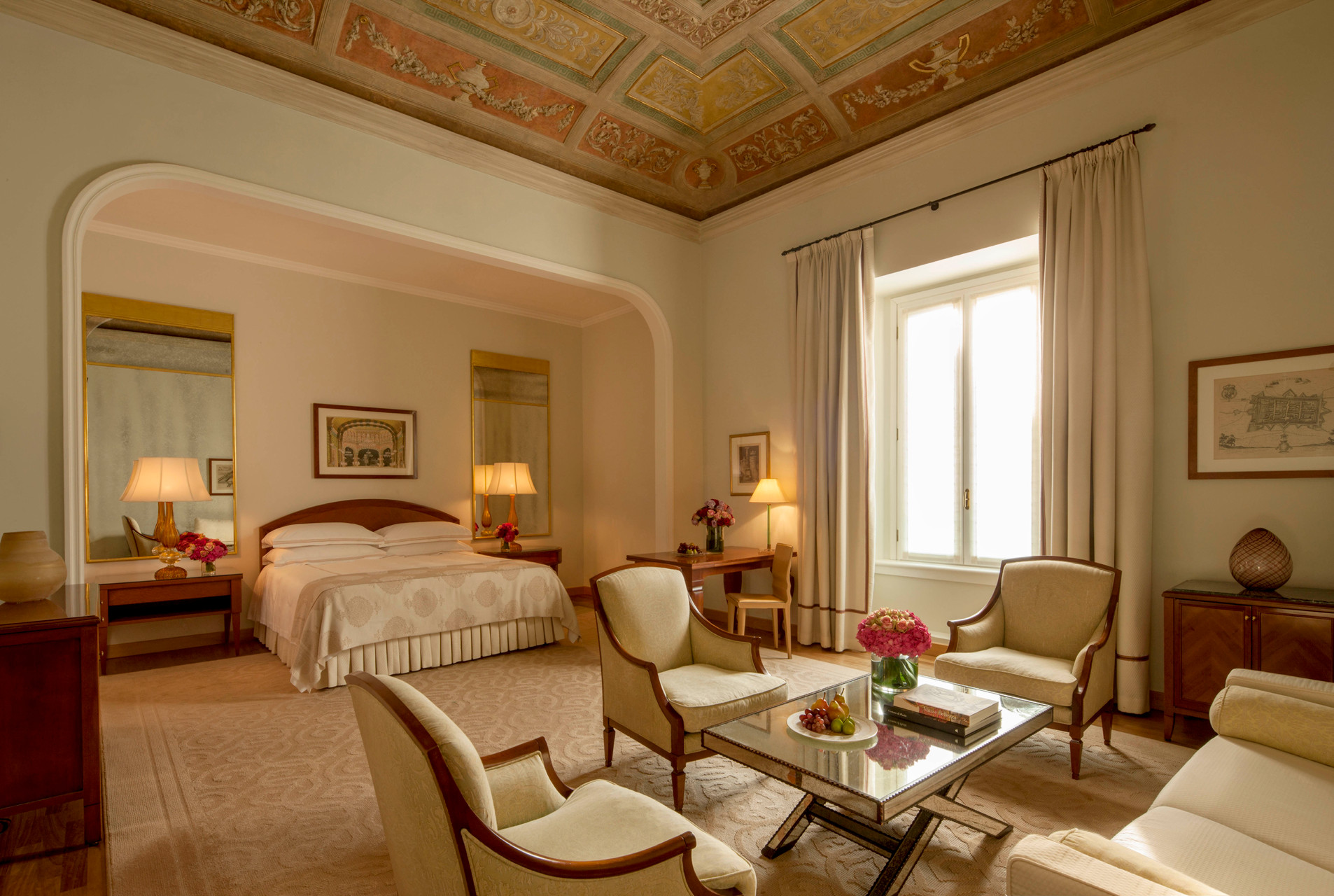 LA
VERANDA
LA
VERANDA
FOUR SEASONS HOTEL MILANO
Via Gesù, 6/8
39 02 77088
When
the Four Seasons Milano opened in 1993 in what
was once a 15th century convent named Santa
Maria del Gesù, no hotel in the city had
anything close to its luxury, service or
amenities, so it set a bar all other hotels,
especially old bastions like the Principe e
Savoia, had to strive quickly to meet.
Today, in its location off the
fashionable Via Gesù, lined with Brioni, Kiton,
Zilli, Versace and other boutiques, the Four
Seasons is still in the top ranks of Milan hotels,
and its restaurant La Veranda has remained among
the most innovative in Italy, now under chef
Barizio Borraccino.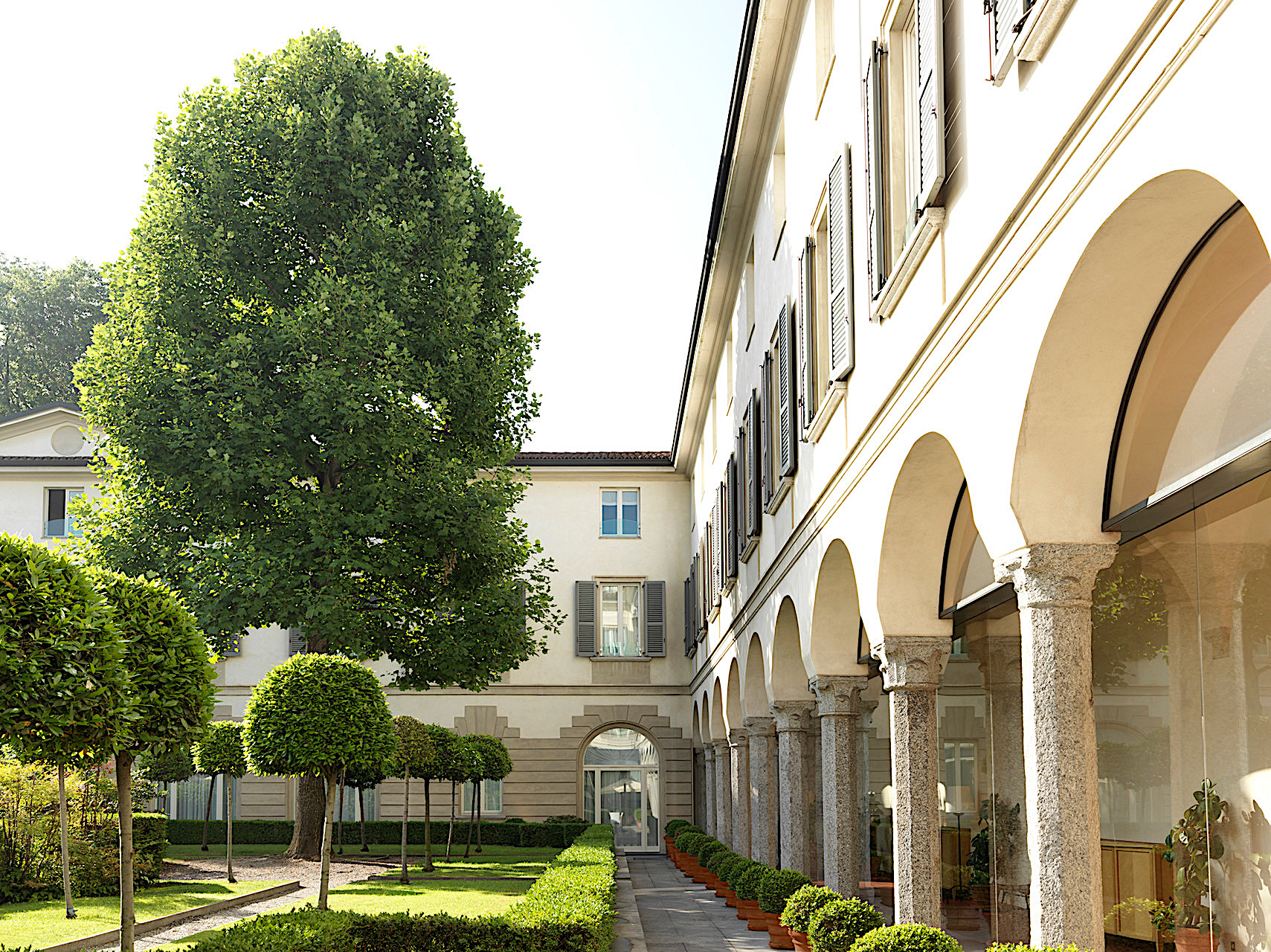
The hotel’s rooms (118 with 50
suites) are large and decorated with a soft
Milanese décor of warm colors in its use of woods,
with poster beds, walk-in closets, fine furniture
with Fortuny fabrics, Frette linens, frescoed
stucco ceilings and Carrara marble bathrooms,
surrounding the original cloister and landscaped
gardens of the nunnery (right). The 8,600-square-foot
spa, which takes advantage of the old arcades, was
designed by Patricia Urquiola (below).
While
expensive,
staying there for three nights allows you a fourth
night free; they also have a family package and
cooking classes are available. Underground parking
is offered, which in the restricted historic
center of Milan can be crucial. And if you want to
get out of town, the concierge can arrange a trip
in a vintage 1960 Giulietta Spider to drive from
Four Seasons property to property all the way to
the Grand-Hôtel du Cap-Ferrat.
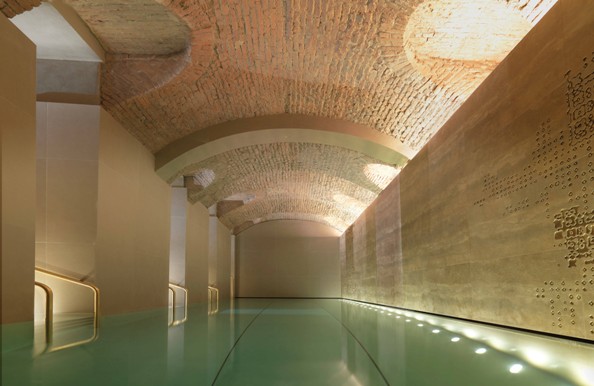 (By
the way, on a day when I had to leave Milan a
declared transit strike that included trains,
metro and buses, The Four Seasons’s concierge made
extraordinary efforts to make it possible for me
to get out of town by private car when taxis and
Uber cars were impossible to find.)
(By
the way, on a day when I had to leave Milan a
declared transit strike that included trains,
metro and buses, The Four Seasons’s concierge made
extraordinary efforts to make it possible for me
to get out of town by private car when taxis and
Uber cars were impossible to find.)
La Veranda’s sophisticated
style, with sunlight from the garden pouring in
during the day through a glass wall and 30 seats
outside in good weather, is a canny balance of
elegance and metropolitan chic that befits its
central position in Milan, and at night, with the
garden lighted, it becomes wonderfully romantic.
Chef
Borraccino, from Abruzzo, creates a menu drawn
from various regions of Italy, and his “La Veranda
Journey” menu (€145, with wine options at €95) is
the best way to appreciate his range.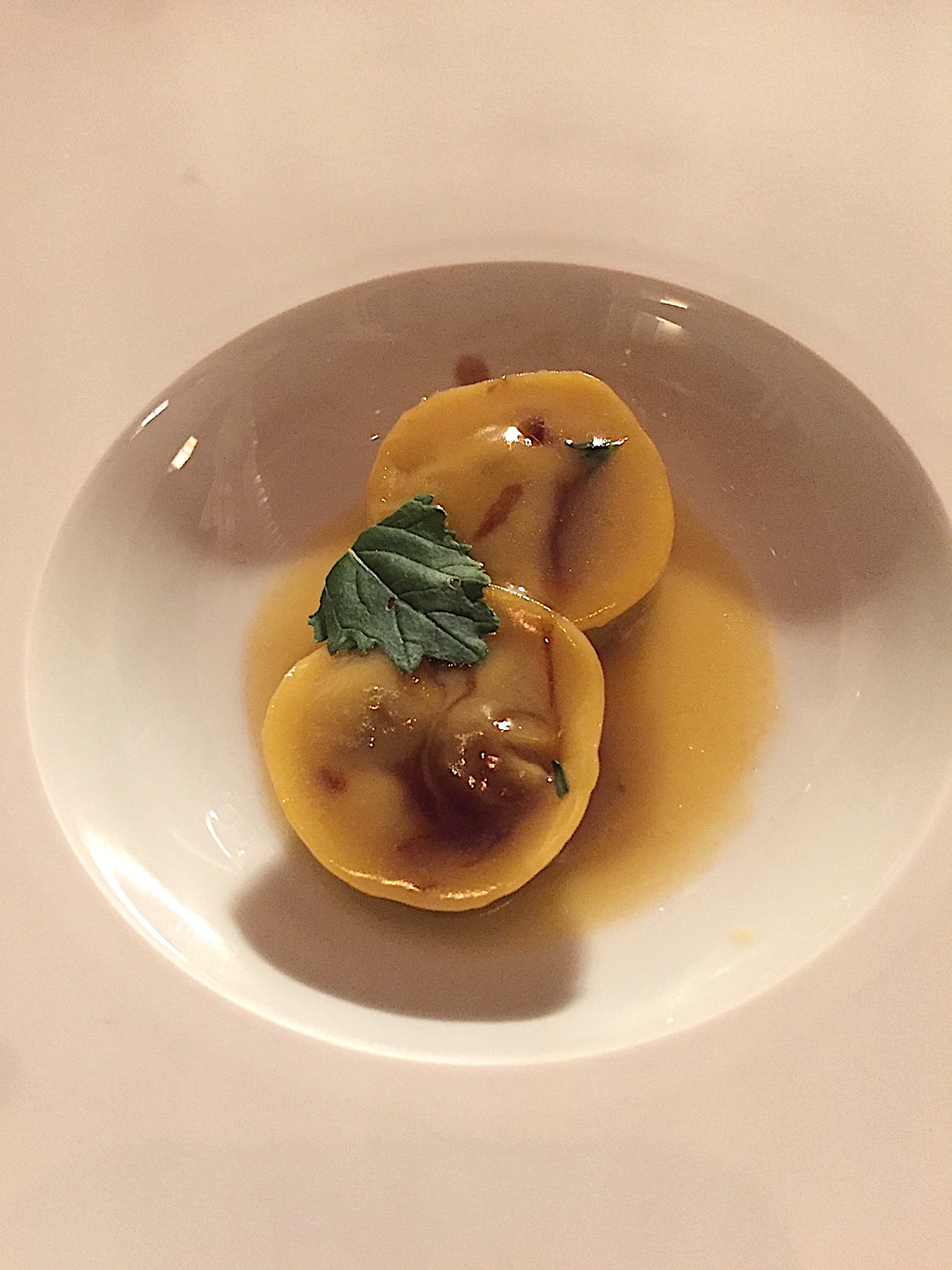
My wife and I began with excellent breads and both
Sicilian and Tuscan olive oils, and a dazzling amuse of
fracciata cream,
robiola fondue
and
black truffles that signaled the level of cuisine
to follow.
Next was a marvelous dish of roast scallops
and rich sea urchin bisque with puntarelle
greens, and sweetbreads seared in butter set in a
green tomato cream with poppy leaves, crispy bread
and caviar farmed in the Po Valley near Brescia.
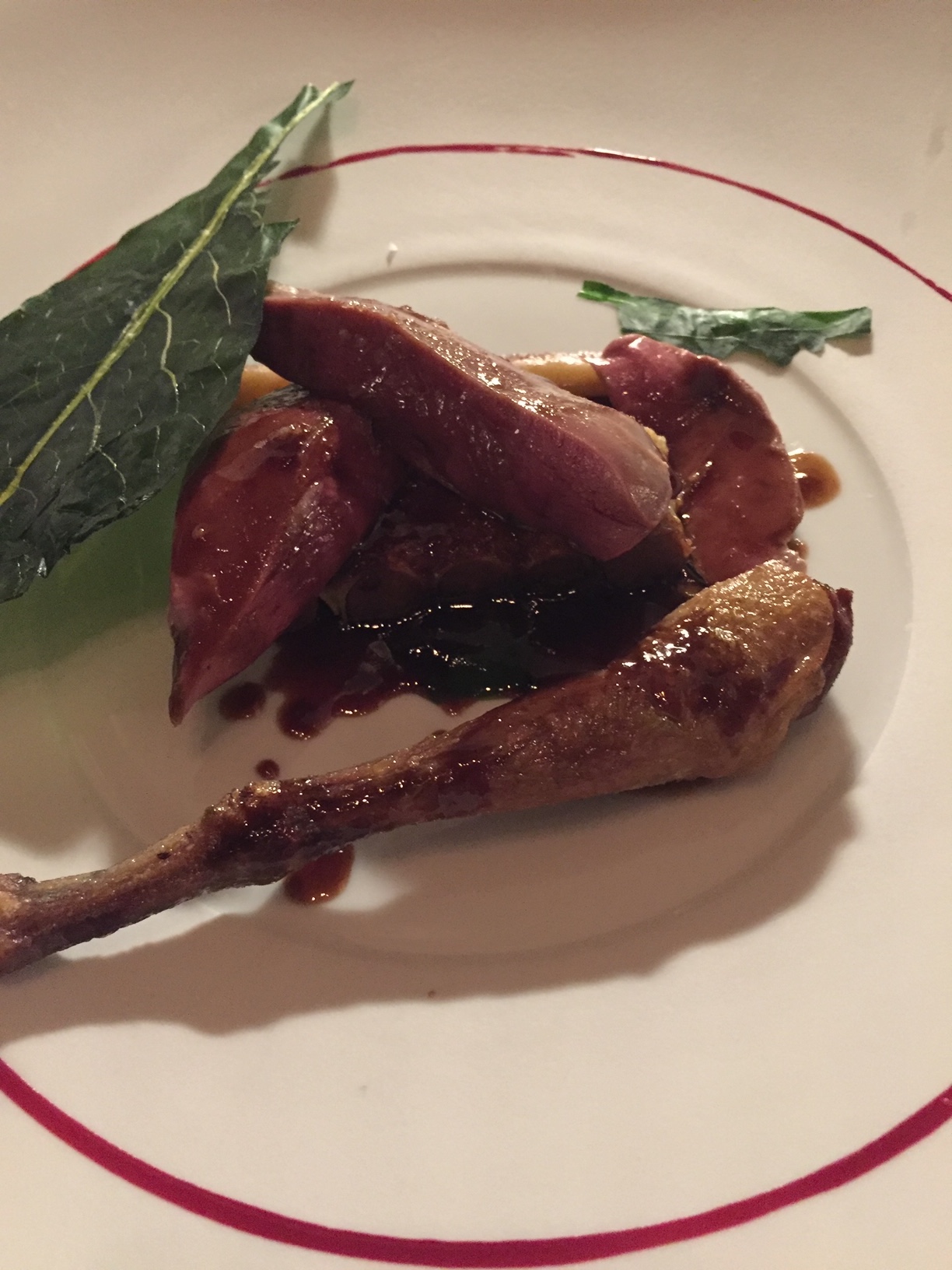 Three
small pasta dishes came next, all house made, that
included two made with tagliolini, one with white
turnip and white truffles, the other a wonderfully
simple and simply delicious version with very
sweet tomatoes, Parmigiano and basil. Tortelli
cuddled a forcemeat of duck in a rich butter sauce
and leaves of thyme (right).
Three
small pasta dishes came next, all house made, that
included two made with tagliolini, one with white
turnip and white truffles, the other a wonderfully
simple and simply delicious version with very
sweet tomatoes, Parmigiano and basil. Tortelli
cuddled a forcemeat of duck in a rich butter sauce
and leaves of thyme (right).
The seafood course was turbot
done à la
meunière with seaweed, potatoes and juicy
razor clams in a surprisingly good candied lemon
sauce. A glistening breast of squab
(left)
braised in a carefully reduced Piemontese red wine
came with cannelloni filled with the stewed leg
meat and sauced with a nettle pesto and coriander
sauce, with black cabbage chips—quite a tour de
force.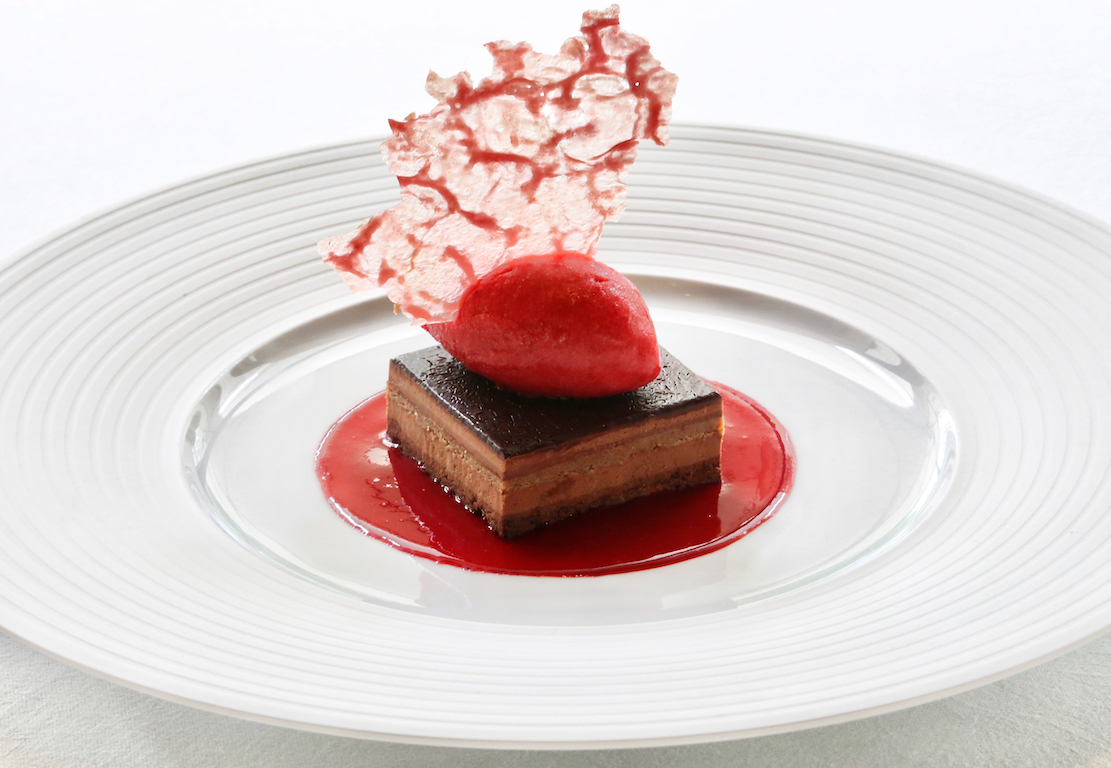
Pastry chef Daniele Bonzi, who
runs a Chocolate Room at the hotel, puts as much
intensity into his sorbets and gelati
as into his beautiful dessert preparations, like
the very pretty and quite intriguing “fake
persimmon,” a candy ball that once broken oozes
pinenuts, pomegranate and chocolate, and his
“chocolate delight” (right) that lived up to its
name: an almond biscuit with hazelnut crumbles,
chocolate mousse with raspberry sauce and an
intensely flavored raspberry sorbet.
Sommelier Antonio Fontana
paired the meal with unusual wines like an
Abruzzese Feudo Antico Passerina Tullum 2018 and a
Ligurian Lunae Colli di Luni “AUXO” 2017.
Such a meal
exemplifies a sumptuous refinement in every
detail, color, texture and complementary flavors,
with the kitchen and service staff working in a
perfect unison that distinguishes Milan dining
right now.
VUN
APREA
PARK HYATT MILAN
Via Tommaso Grossi
02 8821 1234
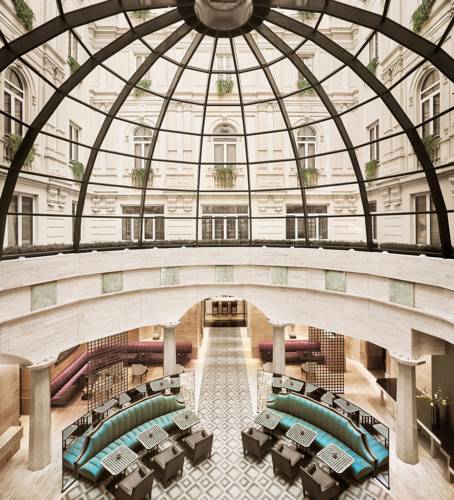 Park
Hyatt Milan opened at the right time—2003—and
right place to be a hospitable anchor for
the Financial District, setting its own standard
of elegance and business efficiency without
appearing corporate. It’s steps away from the
Duomo, La Scala and Galleria and not far from
the Brera. There are 106 guestrooms, including
23 large suites and terraces offering a grand
view of Milan from on high, with décor done with
Jim Thompson silk fabrics, marble baths, Tai
Ping rugs and Murano blown glass. Four penthouse
suites offer a magnificent view of the Duomo and
city skyline. The work desks are spacious and
very well wired. The spa is by Sisley.
Park
Hyatt Milan opened at the right time—2003—and
right place to be a hospitable anchor for
the Financial District, setting its own standard
of elegance and business efficiency without
appearing corporate. It’s steps away from the
Duomo, La Scala and Galleria and not far from
the Brera. There are 106 guestrooms, including
23 large suites and terraces offering a grand
view of Milan from on high, with décor done with
Jim Thompson silk fabrics, marble baths, Tai
Ping rugs and Murano blown glass. Four penthouse
suites offer a magnificent view of the Duomo and
city skyline. The work desks are spacious and
very well wired. The spa is by Sisley.
Just off the lobby is a daunting La Cupola
(above, left)
, whose glass dome echoes the Galleria’s, and is
an ideal place for breakfast or light meal and
meetings. Before dinner you might well wish to
have a cocktail at the Mio Lab, whose name gives
no indication of its shadowy beauty, with
signature cocktails paired with a selection of
bite-sized pintxos.
Here and in the dining room the 50-page wine list
is overseen by Michele d’Emilio.
The
beautiful, shadowy restaurant VUN Andrea Aprea (“vun” is
Milanese dialect for “one”) has since 2011 been
the namesake of Neapolitan-born chef Andrea Aprea
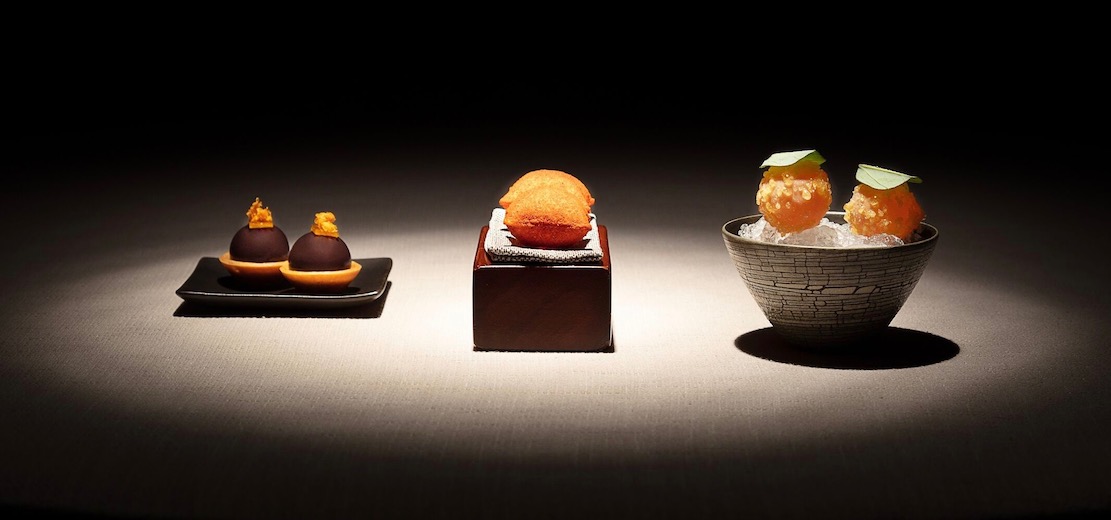 (below),
whose motto, “My contemporary
cuisine looks to
(below),
whose motto, “My contemporary
cuisine looks to 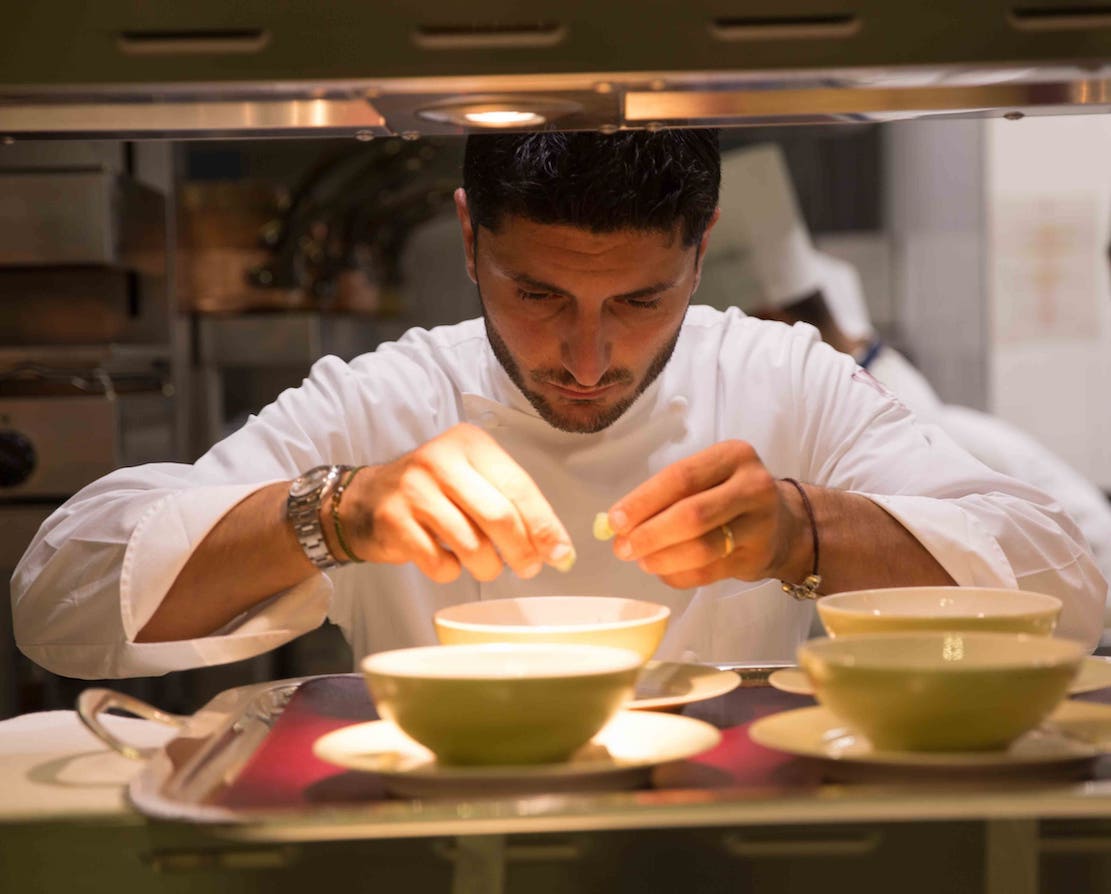 the future, but never
forgets its origins,” is exemplified in both his
Lombardian and Neapolitan dishes, some admirably
simple, others with a dash of modernist technique.
the future, but never
forgets its origins,” is exemplified in both his
Lombardian and Neapolitan dishes, some admirably
simple, others with a dash of modernist technique.
My wife and I were treated to
three canapés at the start, along with a glass of
Mailly Rosé: One was an apple-like ball with
bittersweet Aperol; another a pink pillow of
goat’s cheese; the third, olives in a delicate
pastry shell (above).
A signature dish that shows how Aprea brings a
2020 sensibility into traditional cooking is his
“Caprese Sweet and Salty,” a complex preparation
that begins with a candy sphere into which is
pumped mozzarella foam—he says it is “a similar
technique to blowing Murano glass”—served with a
tomato coulis
and basil emulsion, mozzarella croutons and
anchovies. Gaja’s light red 2018 Rossj Bass
accompanied this dish.
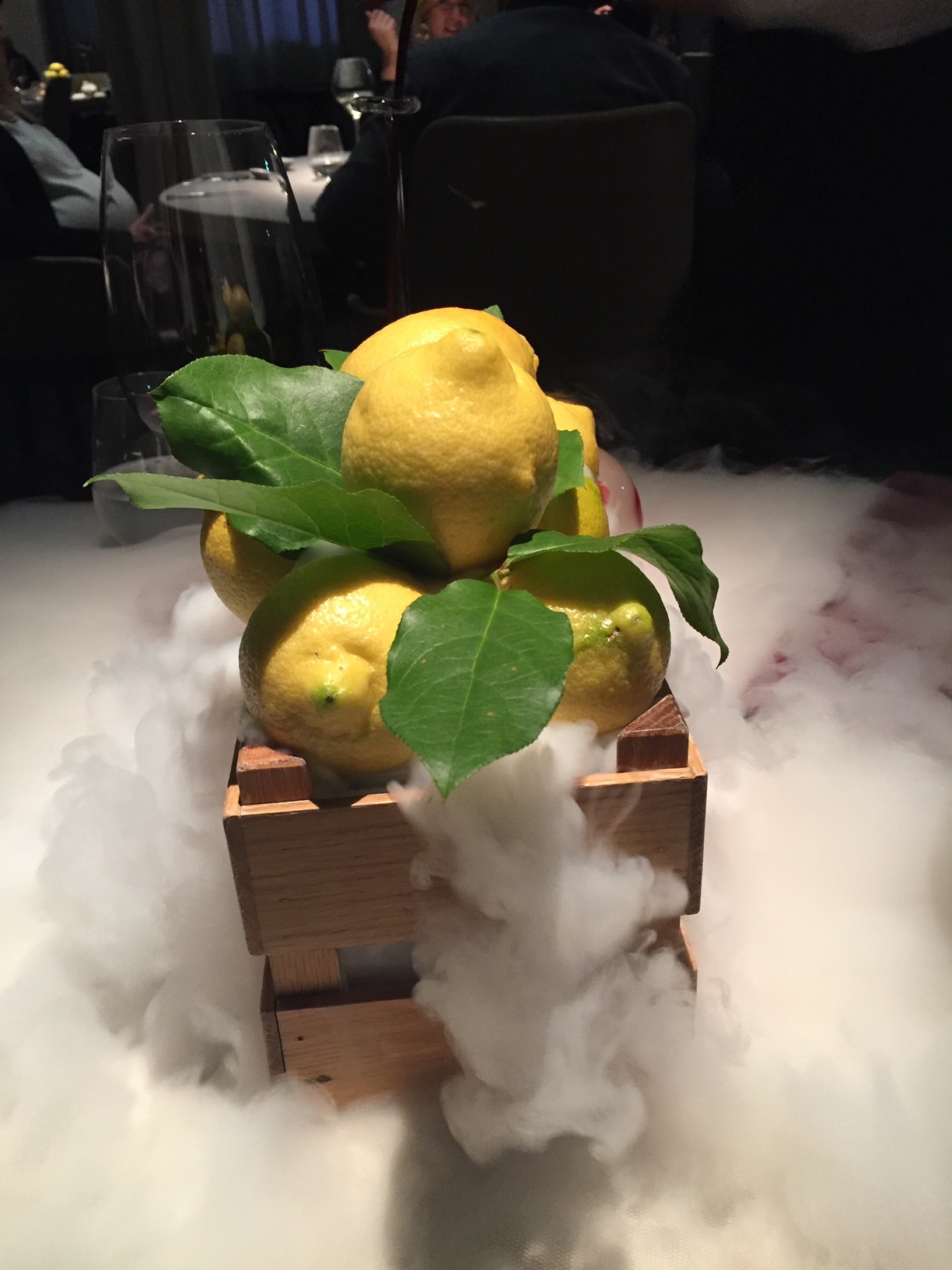 A sharp
horseradish puree enlivens a cuttlefish “diavola”
(devil’s style), whereby Aprea takes the classic
Roman dish of pasta
all’amatriciana, made with onion and chili
peppers, instead using potatoes baked in foil with
an onion puree, with the steam causing all the
flavors to coalesce within the enclosure. Tortello
pasta is a small cake with whipped buffalo ricotta
cheese and a “double concentration” of Neapolitan
ragù.
His “Sub Marine” risotto is mixed with seafood
brightened by a montage of three colors via red
and green seaweed and black squid ink.
A sharp
horseradish puree enlivens a cuttlefish “diavola”
(devil’s style), whereby Aprea takes the classic
Roman dish of pasta
all’amatriciana, made with onion and chili
peppers, instead using potatoes baked in foil with
an onion puree, with the steam causing all the
flavors to coalesce within the enclosure. Tortello
pasta is a small cake with whipped buffalo ricotta
cheese and a “double concentration” of Neapolitan
ragù.
His “Sub Marine” risotto is mixed with seafood
brightened by a montage of three colors via red
and green seaweed and black squid ink.
Next came “Salt Cod in Autumn”
with a rich mayonnaise and porcini broth,
and “Pork 100 Hours” that is actually barbecued
then served with provola cheese,
honey and chili, with which we sipped a big 2014
Castiglion del Bosco Brunello di Montalcino.
Aprea’s desserts have always
been spectacular, especially his lemon sensation
that billows dramatically with dry ice from its
shell (left).
There was also a Neapolitan spiced cake/candy
called panforte
at the end with a glass of Muratori Tenuta
Giardini passito
dessert wine.
Incidentally,
valet parking is complementary at the restaurants
and bars; self-parking is €50 for 24 hours.
❖❖❖
By John Mariani
150 Nassau Street (near Spruce Street)
212- 619-1200
As
many steakhouses as there are in America, no
other city has the sheer variety New York
does—Italian steakhouses, French steakhouses,
Korean steakhouses, Japanese steakhouses,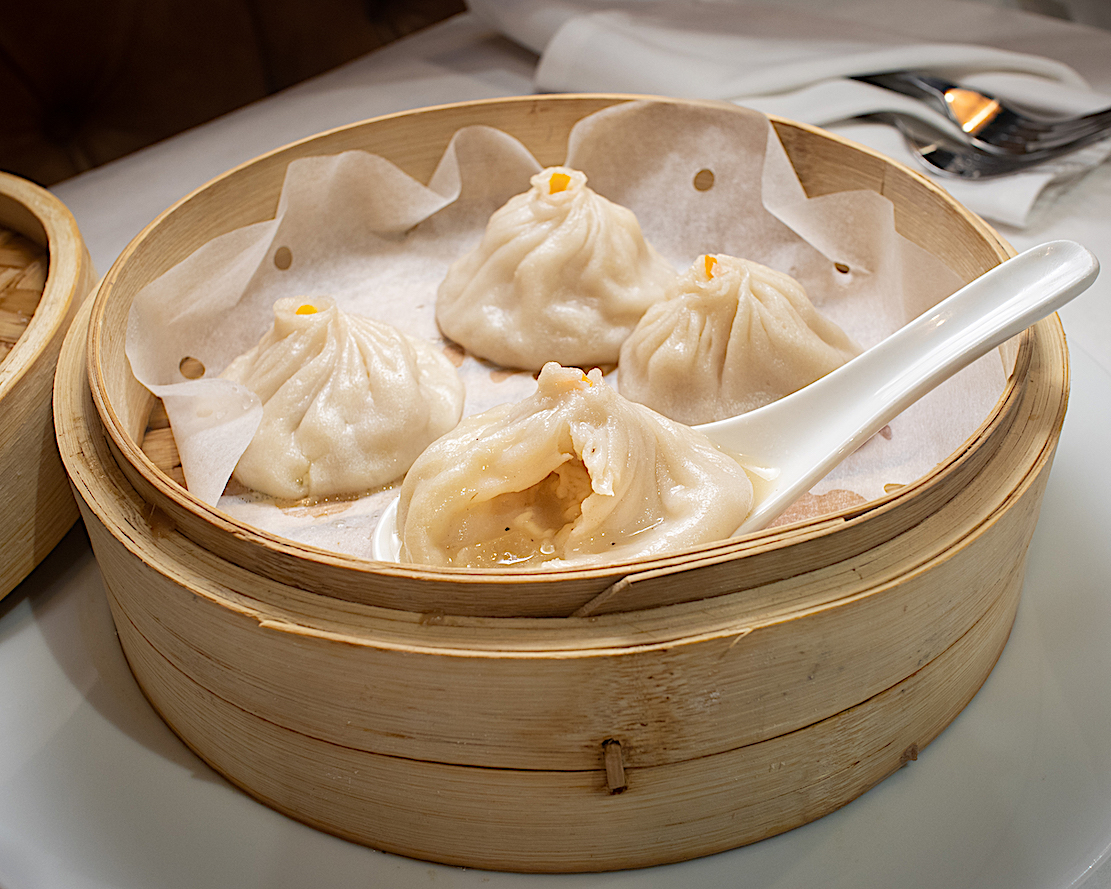 Rumanian steakhouses
and kosher steakhouses. Now, at the Brooklyn
Chop House (which is near the Brooklyn Bridge
but actually in downtown Manhattan), owners
Stratis Morfogen, tech entrepreneur Dave Thomas
and music industry impresario Robert "Don Pooh"
Cummins have given New York a steakhouse in
which the first part of the menu would fit
handily into any in Chinatown, while the main
courses exemplify the best of what has long
served as a venerable template for steakhouses
around the country.
Rumanian steakhouses
and kosher steakhouses. Now, at the Brooklyn
Chop House (which is near the Brooklyn Bridge
but actually in downtown Manhattan), owners
Stratis Morfogen, tech entrepreneur Dave Thomas
and music industry impresario Robert "Don Pooh"
Cummins have given New York a steakhouse in
which the first part of the menu would fit
handily into any in Chinatown, while the main
courses exemplify the best of what has long
served as a venerable template for steakhouses
around the country.
The idea
for Brooklyn Chop House began as a summer pop-up
restaurant in Southampton and debuted in the
Financial District a year ago, its name a play on
both a meat chop and chopsticks, of which,
Morfogen says, “There might not be a restaurant on
Earth that can serve a four-pound salt and pepper
lobster, alongside a 55-day prime dry-aged
Porterhouse steak and a seven-pound slow-roasted
Peking Duck, but that's what sets our restaurant
apart.” He
calls that trio by their first initials: “LSD.”
Morfogen has a long résumé in
the restaurant business (his father ran five
Chelsea Chop Houses) as an investor in Gotham City
Diner, Seagrill of the Aegean, Philippe Chow and
Jue Lan Club. He also opened a sushi-steakhouse
fusion restaurant called Jade 60 on the upper east
side that closed after six months. Next year his
first book, Damn
Good Dumplings, will be published.
Brooklyn Chop House is a very
handsome space on the corner of Nassau and Spruce
Streets in an 1896 Beaux-Arts building. With150
seats in the dining room and 35 more in the bar,
the décor is fairly traditional, with exposed
ceiling duct work, brick walls, hanging lamps,
bentwood chairs, leather banquettes and snowy
white tablecloths, all softened by gauzy curtains. The
sound level is very amiable, even when full.
Given
Cummins’s connection to the music industry, the
dinner crowd has included a slew of celebrities
including Meek Mill, J. Cole, Fat Joe, Mary
J. Blige, Spike Lee, Omari Hardwick, Trey Songz, Chaka Khan, Wendy Williams and
Jamie Foxx.
When Morfogen is on the
premises you can be sure his eye is roaming every
square inch, and to chat with him is to discover
just how passionately committed he is to Chinese
dishes treated with some New York chutzpah, along
with first-rate beef, aged 35-55 days.
Since dumplings take so many
forms in Chinese cuisine—at least seven basic
shapes and styles, from siu mai
to har go,
bao zi to jaozi—Morfogen
commits no transgressions when he stuffs his with
ingredients you won’t find in Canton. One bite of
his pastrami-stuffed dumpling (they all range from
$14 to $16 for five pieces) and you’ll wonder why
no one had ever thought of this before. You’ll
ask the same question when you bite into his
Philly cheese steak dumplings and the fantastic
French onion soup dumpling that splashes into your
mouth with myriad flavors.
Within
that LSD trio, it’s difficult for me to tell you
which one is the best choice. That big lobster
(market price for two) is available with salt and
pepper and suffused with seasonings while
remaining very juicy and easy to pick from the
shell. The
Peking duck ($65), shiny as mahogany, is brought
to your table and deftly carved and served in
large pancakes; I am a bit surprised that the dish
is not served in the traditional three courses—the
skin with hoisin sauce in pancakes or buns; the
meat with vegetables; then duck soup—but this is
still a wonderful, festive dish.
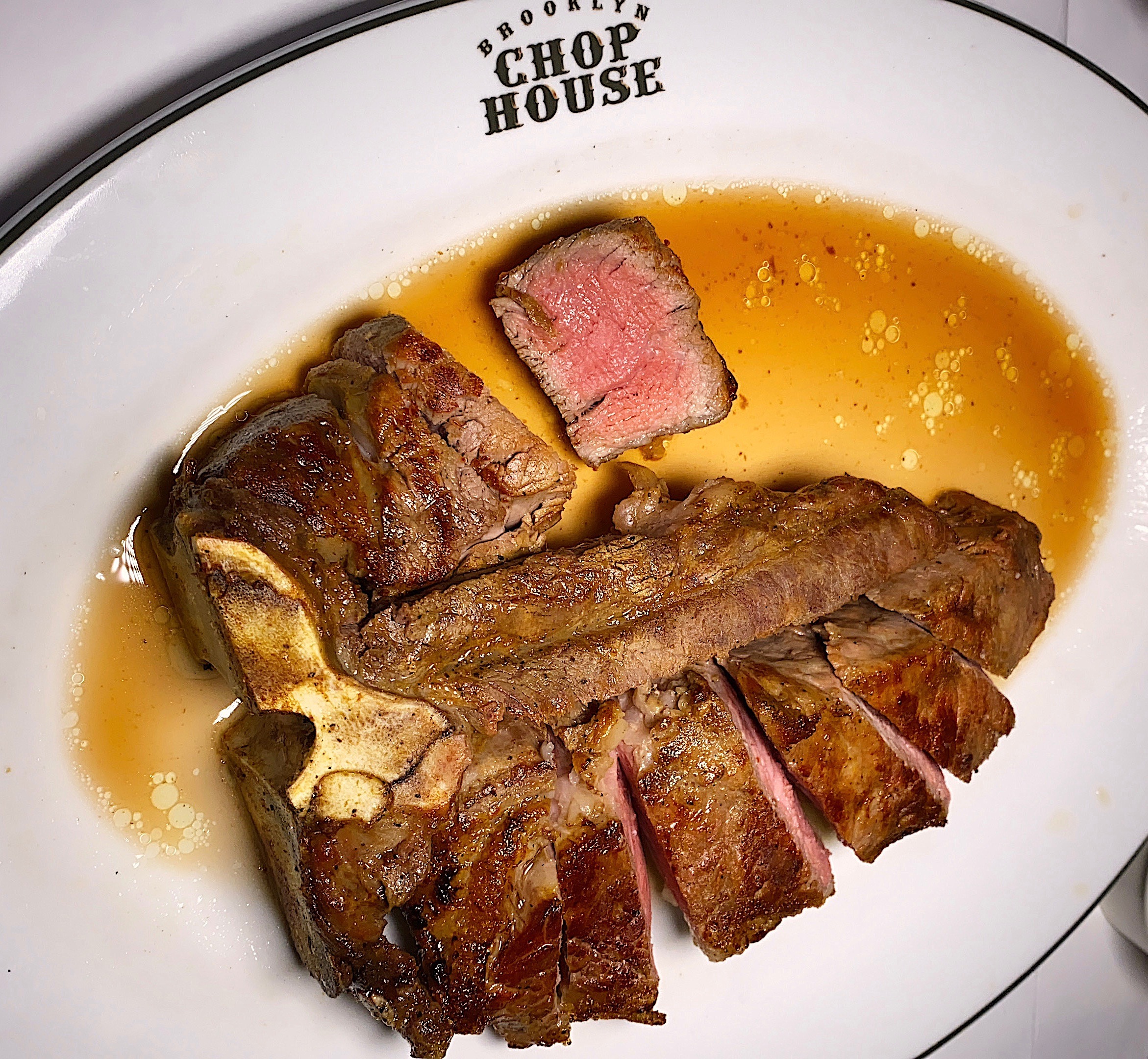 And so you get to the
steaks and chops. Our table enjoyed the 48-ounce
dry- aged porterhouse ($125), listed for two, but
believe me, if you’ve enjoyed dumplings or small
plates or satays prior to the main course, this
massive piece of beef is going to serve three or
even more, and we took some home. Of the beef
itself, which is aged 55 days, let me say that
past 28 days aging beef may or may not have much
effect on flavor, but careful
aging, as here, does. This porterhouse had
tremendous flavor, slightly funky, which is the
way New York steakhouses used to serve Prime beef
and so rarely do these days. If you love that
flavor, as I do, this is one of the best steaks
you can find in the city. If not, other steak
options on the menu are not aged that long.
And so you get to the
steaks and chops. Our table enjoyed the 48-ounce
dry- aged porterhouse ($125), listed for two, but
believe me, if you’ve enjoyed dumplings or small
plates or satays prior to the main course, this
massive piece of beef is going to serve three or
even more, and we took some home. Of the beef
itself, which is aged 55 days, let me say that
past 28 days aging beef may or may not have much
effect on flavor, but careful
aging, as here, does. This porterhouse had
tremendous flavor, slightly funky, which is the
way New York steakhouses used to serve Prime beef
and so rarely do these days. If you love that
flavor, as I do, this is one of the best steaks
you can find in the city. If not, other steak
options on the menu are not aged that long.
(By the way, Morfogen recently
ditched the menu’s New Zealand lamb chops for the
much finer American product.)
Okay, so you’re in a Chinese
steakhouse. Do you really need dessert? Probably
not, and I found the sorbets somewhat icy in
texture.
If Brooklyn
Chop House’s modus operandi is not unique, I know
of no other restaurant in New York that does it
with such obvious commitment to quality across the
menu and with such panache. My only regret is that
I live an hour away by car, but I’ll happily make
the drive and may one day come in for their
Saturday and Sunday brunch, at $39.95 for
unlimited dim sum. I’d like to find out just what
my limit is.
Open daily for lunch and dinner.
❖❖❖
By Geoff Kalish
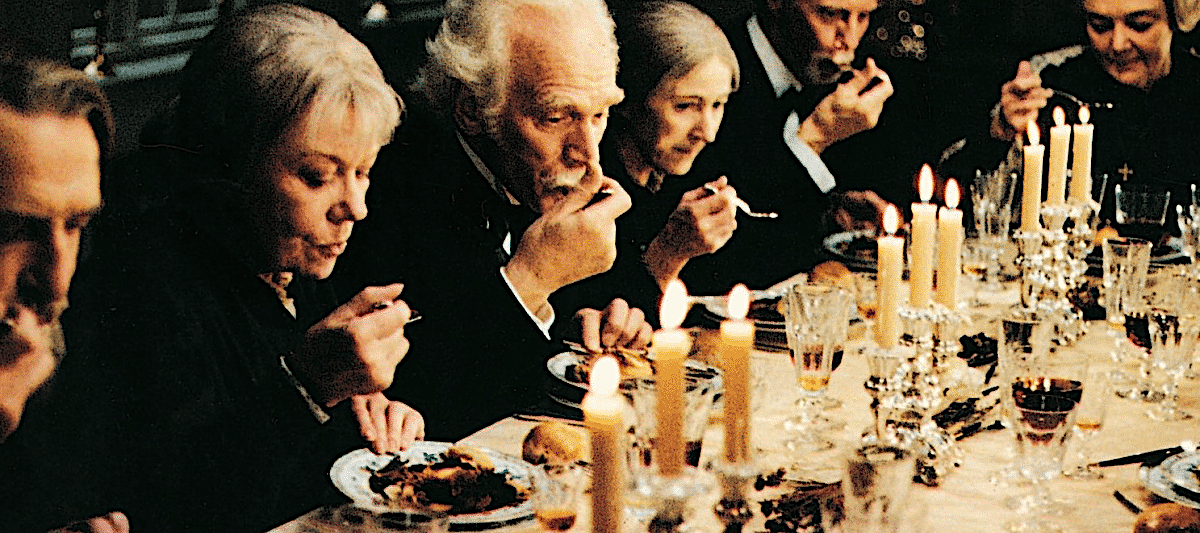
"Babette's Feast"
While
many whites, like Pinot Grigio and Chablis, are
often overwhelmed by the heady flavors of
winter-time fare, it’s no wonder that many wine
consumers favor reds to accompany seasonal
favorites like chicken cacciatore, pasta with
meat sauce and beef or lamb stews. However,
based on a number of recent pairings, I’ve found
that there are more than one or two reasonably
priced, widely available whites that can weather
the storm of cold weather fare.
 2017
Zind-Humbrecht Gewürztraminer ($25)—Hailing
from one of the premier producers in Alsace, this
wine was made from grapes grown in gravelly soil
on vines almost 50 years old. It has a distinctive
bouquet and taste of lychee nuts and ginger with
hints of exotic spice and a crisp finish. However,
this is not a lush wine that shows its fruit as
soon as it hits your palate but one whose flavor
lingers long after it’s swallowed and makes great
accompaniment for braised beef with sweet onions
or pork with prunes.
2017
Zind-Humbrecht Gewürztraminer ($25)—Hailing
from one of the premier producers in Alsace, this
wine was made from grapes grown in gravelly soil
on vines almost 50 years old. It has a distinctive
bouquet and taste of lychee nuts and ginger with
hints of exotic spice and a crisp finish. However,
this is not a lush wine that shows its fruit as
soon as it hits your palate but one whose flavor
lingers long after it’s swallowed and makes great
accompaniment for braised beef with sweet onions
or pork with prunes.
2017 Jordan
Chardonnay ($34)—Following
harvest
of the grapes (100% Russian River Valley
Chardonnay), fermentation was conducted over two
weeks in a combination of new French oak barrels
(61%) and stainless steel (39%). This was followed
by five weeks of aging on its lees and six months
in new French oak barrels, all of which gives this
wine a toasty bouquet and taste with notes of
pears and peaches and a lemony finish and an
elegant taste. Yet it is bold enough to provide
worthy accompaniment for roast chicken or salmon
dishes.
2018 Nik Weiss St.
Urbans-Hof Bockstein Kabinett Riesling ($21)—This slightly
sweet, low alcohol (9%) 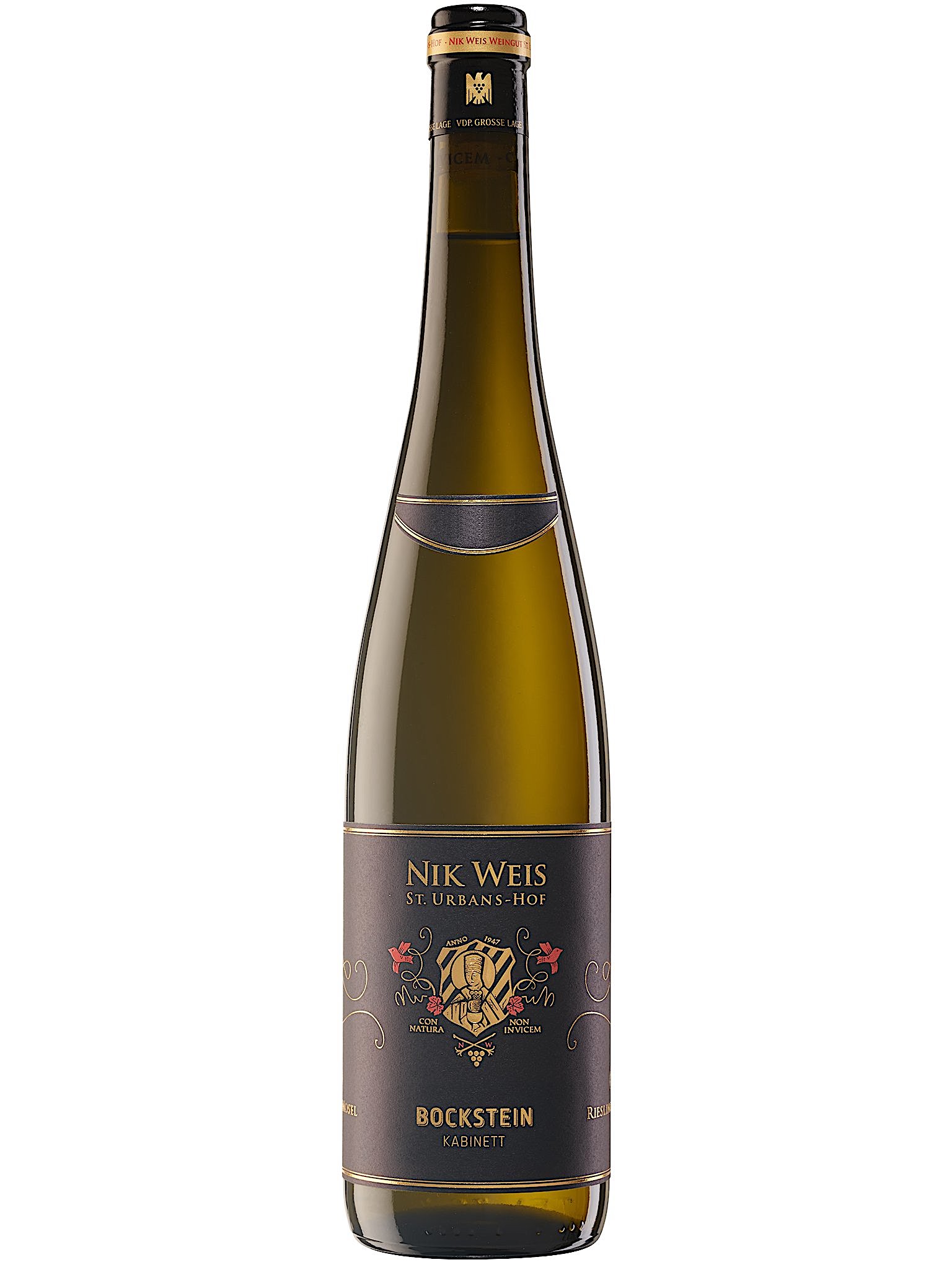 wine from
Germany’s Saar Valley has a fragrant bouquet and
taste of apples and honey with a bit of gooseberry
in its finish. It makes perfect accompaniment to
spicy Asian fare, like Indian vindaloos, fiery
Szechuan fare and tangy Thai specialties.
wine from
Germany’s Saar Valley has a fragrant bouquet and
taste of apples and honey with a bit of gooseberry
in its finish. It makes perfect accompaniment to
spicy Asian fare, like Indian vindaloos, fiery
Szechuan fare and tangy Thai specialties.
2017 Domaine Pichot
“Domaine Le Peu de la Moriette” Vouvray ($17)—For this bottle
from France’s Loire Valley, proprietor Jean-Claude
Pichot uses
hand-picked grapes, with fermentation and
aging in oak. And while not usually thought of as
a winter-time wine, this easy-drinking semi-sweet
white has a floral bouquet and flavor of white
peaches and apricots with a touch of honey in its
lively finish that makes ideal accompaniment to a
range of hors d’oeuvres and appetizers from smoked
salmon to roasted beets and fish tacos. It also
pairs particularly well with sushi and sashimi.
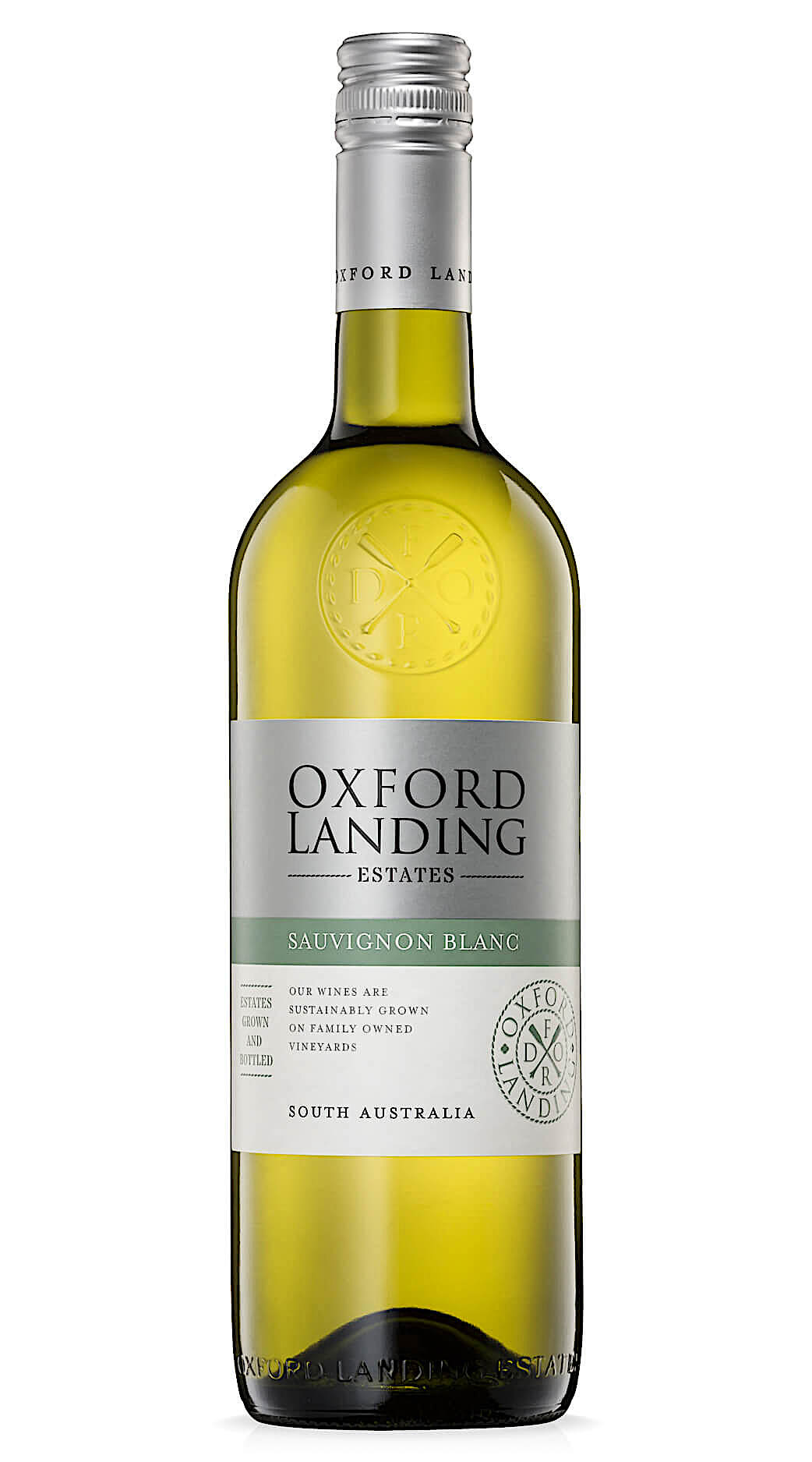
2019 Oxford Landing
Sauvignon Blanc ($10)—The
grapes in this bargain bottle from South
Australia’s Murray River area were fermented at
cool temperatures, with a percentage left on its
skins for added complexity. It has a fragrant
bouquet and assertive taste of pineapple, passion
fruit and grapefruit, with a crisp citrusy finish
and mates well with hearty dishes like mushroom
and barley risotto or cassoulet.
2017 Ciro Picariello
Fiano di Avellino DOCG ($25)—This
wine was fashioned from hand-picked grapes grown
in the hills of Campania, in southwest Italy.
Following fermentation using indigenous grapes, it
is aged on its lees for 12 months before bottling.
It shows a bouquet and taste of peaches and lemons
with lively acidity in its finish, perfect to
match with appetizers of piquillo peppers and
charred Brussels sprouts, as well as main courses
of veal or chicken Parmesan and pasta with red
sauce.
❖❖❖

EVEN THOUGH MESQUITE IS NATIVE TO NORTH AMERICA
"The
Tadich Grill became
a full-service restaurant in 1887 when employee John
Tadich bought it. The restaurant claims to be the first
in the U.S. to grill seafood over mesquite charcoal, a
cooking method Tadich used growing up in his native
Croatia."—Dan Meyers and Syjil Ashraf, "The Oldest
Restaurant in Every State," Daily Meal (2/2/20).
January 2, 2020
THIS JUST MIGHT BE TRUE

In an article
in Eater.com,
LA Restaurant Industry Experts gave their thoughts on
the “Biggest Dining Surprises of 2019.” According to
Stephanie Breijo, Time
Out
La Editor, it was, “Nic Cage singing post-divorce 'Purple Rain'
in a K-town karaoke bar.”
Any of John Mariani's books below may be ordered from amazon.com.
 The Hound in Heaven
(21st Century Lion Books) is a novella, and
for anyone who loves dogs, Christmas, romance,
inspiration, even the supernatural, I hope you'll find
this to be a treasured favorite. The story
concerns how, after a New England teacher, his wife and
their two daughters adopt a stray puppy found in their
barn in northern Maine, their lives seem full of promise.
But when tragedy strikes, their wonderful dog Lazarus and
the spirit of Christmas are the only things that may bring
his master back from the edge of despair.
The Hound in Heaven
(21st Century Lion Books) is a novella, and
for anyone who loves dogs, Christmas, romance,
inspiration, even the supernatural, I hope you'll find
this to be a treasured favorite. The story
concerns how, after a New England teacher, his wife and
their two daughters adopt a stray puppy found in their
barn in northern Maine, their lives seem full of promise.
But when tragedy strikes, their wonderful dog Lazarus and
the spirit of Christmas are the only things that may bring
his master back from the edge of despair. WATCH THE VIDEO!
“What a huge surprise turn this story took! I was completely stunned! I truly enjoyed this book and its message.” – Actress Ali MacGraw
“He had me at Page One. The amount of heart, human insight, soul searching, and deft literary strength that John Mariani pours into this airtight novella is vertigo-inducing. Perhaps ‘wow’ would be the best comment.” – James Dalessandro, author of Bohemian Heart and 1906.
“John Mariani’s Hound in Heaven starts with a well-painted portrayal of an American family, along with the requisite dog. A surprise event flips the action of the novel and captures us for a voyage leading to a hopeful and heart-warming message. A page turning, one sitting read, it’s the perfect antidote for the winter and promotion of holiday celebration.” – Ann Pearlman, author of The Christmas Cookie Club and A Gift for my Sister.
“John Mariani’s concise, achingly beautiful novella pulls a literary rabbit out of a hat – a mash-up of the cosmic and the intimate, the tragic and the heart-warming – a Christmas tale for all ages, and all faiths. Read it to your children, read it to yourself… but read it. Early and often. Highly recommended.” – Jay Bonansinga, New York Times bestselling author of Pinkerton’s War, The Sinking of The Eastland, and The Walking Dead: The Road To Woodbury.
“Amazing things happen when you open your heart to an animal. The Hound in Heaven delivers a powerful story of healing that is forged in the spiritual relationship between a man and his best friend. The book brings a message of hope that can enrich our images of family, love, and loss.” – Dr. Barbara Royal, author of The Royal Treatment.
 |
The Encyclopedia of American Food and Drink by John F. Mariani (Bloomsbury USA, $35) Modesty forbids me to praise my own new book, but let me proudly say that it is an extensive revision of the 4th edition that appeared more than a decade ago, before locavores, molecular cuisine, modernist cuisine, the Food Network and so much more, now included. Word origins have been completely updated, as have per capita consumption and production stats. Most important, for the first time since publication in the 1980s, the book includes more than 100 biographies of Americans who have changed the way we cook, eat and drink -- from Fannie Farmer and Julia Child to Robert Mondavi and Thomas Keller. "This book is amazing! It has entries for everything from `abalone' to `zwieback,' plus more than 500 recipes for classic American dishes and drinks."--Devra First, The Boston Globe. "Much needed in any kitchen library."--Bon Appetit. |
"Eating Italian will never be the same after reading John Mariani's entertaining and savory gastronomical history of the cuisine of Italy and how it won over appetites worldwide. . . . This book is such a tasteful narrative that it will literally make you hungry for Italian food and arouse your appetite for gastronomical history."--Don Oldenburg, USA Today. "Italian
restaurants--some good, some glitzy--far
outnumber their French rivals. Many of
these establishments are zestfully described
in How Italian Food Conquered the World, an
entertaining and fact-filled chronicle by
food-and-wine correspondent John F.
Mariani."--Aram Bakshian Jr., Wall Street
Journal.
"Equal parts
history, sociology, gastronomy, and just
plain fun, How Italian Food Conquered the
World tells the captivating and delicious
story of the (let's face it) everybody's
favorite cuisine with clarity, verve and
more than one surprise."--Colman Andrews,
editorial director of The Daily
Meal.com. "A fantastic and fascinating
read, covering everything from the influence
of Venice's spice trade to the impact of
Italian immigrants in America and the
evolution of alta cucina. This book will
serve as a terrific resource to anyone
interested in the real story of Italian
food."--Mary Ann Esposito, host of PBS-TV's
Ciao
Italia. "John Mariani has written the
definitive history of how Italians won their
way into our hearts, minds, and
stomachs. It's a story of pleasure over
pomp and taste over technique."--Danny Meyer,
owner of NYC restaurants Union Square
Cafe, The Modern, and Maialino.
|
 |
 |
 |
 |
 |
 |
 |
 |
 Everett Potter's Travel Report:
Everett Potter's Travel Report: 
 Eating Las Vegas
JOHN CURTAS has been covering the Las Vegas
food and restaurant scene since 1995. He is
the co-author of EATING LAS VEGAS – The 50
Essential Restaurants (as well as
the author of the Eating Las Vegas web site: www.eatinglasvegas.
He can also be seen every Friday morning as
the “resident foodie” for Wake Up With the
Wagners on KSNV TV (NBC) Channel 3 in
Las Vegas.
Eating Las Vegas
JOHN CURTAS has been covering the Las Vegas
food and restaurant scene since 1995. He is
the co-author of EATING LAS VEGAS – The 50
Essential Restaurants (as well as
the author of the Eating Las Vegas web site: www.eatinglasvegas.
He can also be seen every Friday morning as
the “resident foodie” for Wake Up With the
Wagners on KSNV TV (NBC) Channel 3 in
Las Vegas.
MARIANI'S VIRTUAL GOURMET
NEWSLETTER is published weekly. Publisher: John Mariani. Editor: Walter Bagley. Contributing Writers: Christopher Mariani,
Robert Mariani, Misha Mariani, John A. Curtas, Gerry Dawes, Geoff Kalish,
and Brian Freedman. Contributing
Photographer: Galina Dargery. Technical
Advisor: Gerry
McLoughlin.
If you wish to subscribe to this
newsletter, please click here: http://www.johnmariani.com/subscribe/index.html
© copyright John Mariani 2020

